In a small art group that Jer and I belong to, we were given a challenge: for the next meeting, we were each to create some form of art based on “biscuits.” That meeting will be next week. I have to make some art. Using “biscuits” I came up with an anagram: “is Cubist.” I will make a Cubist-style painting, containing biscuits.
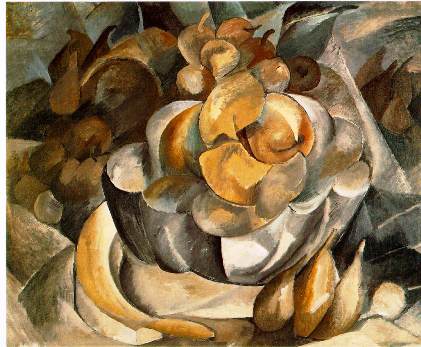
I thought the exercise would be simple. I would look at some Cubist works, get a couple books from the library and raid my bookshelves to see what others had to say, decide on motifs beyond the biscuits, and do a few sketches. Then, I would be ready to paint.
I turned to the internet to see what “making a Cubist painting” would turn up. ArtLex’s definition of Cubism is as good as any although none cover the full range of possible elements. Lots of middle-school curricula appear on the internet, it turns out, with detailed descriptions of assignments, most of them focusing on fragmentation and monochromism. Good for vocabulary, I thought, but not so useful for actually making the painting. Also a description of how to mock up a Cubist work on Photoshop, print it out, and then paint it. I’m reserving that one for when all else fails.
My pencil-sketches and sketch-paintings now number 20 and are still so rough that I shudder to look at them. The books had bits and pieces of useful information but tend to be dense and hard to wade through to get to the helpful stuff. Finding the most appropriate motifs turn out to have its own difficulties. I have settled on the biscuits, strawberries for color, and a vase or jug to give verticality. For its shape, I added the Betty Crocker (Bisquick) spoon to the motifs. I will be doing a still life, of course.
Assembling these items into something a casual on-looker would look at as cubist is yet to be accomplished.
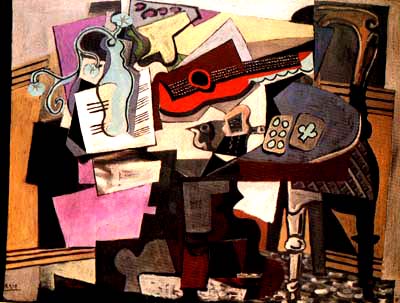
Here’s some of what I have to think about: the interplay of a mulitiplicity of fragmented elements, pulled together across the picture plane, fitting into one another while retaining integrity, playing with motifs while transmuting them, – space, shading, monochromes, taut geometries somehow both beneath the primary forms but strongly influencing them, all elements that are not necessarily part of the fragmentation of the image but are necessary to carry out the picture plane.
And that doesn’t begin to deal with the real questions of art — what is it I am trying to evoke, to communicate, to unveil, to show?
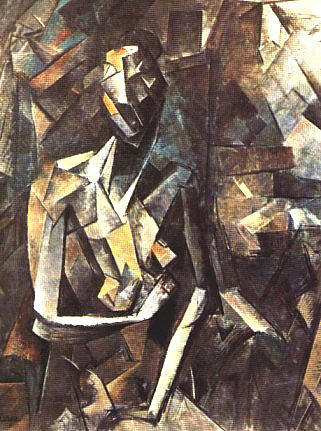
“Where/how to begin?” How to make the translucencies, the transparencies, that pierce and interplay. According to Lucia Salemme (in her excellent book of exercises called Composition,) a light source is essential. That much I can manage.
Geometries — the cylinder, the sphere, the cone, the cube. A contemporary of the Cubists, Andre Salmon, called cubism “painting as algebra.” I have not been good at math since 10th grade. My feeling for math is very like my feeling for Cubism. I respect but don’t love either.
I was relieved, however, to find that the Cubists permitted recognizable tables, and even used table legs and chairs as part of their still life compositions. It seemed important to them that bits of objects be recognizable (an eye, a breast, guitar frets, a pear, a table leg). Other bits seem to be fillers, negative space, carefully considered no doubt, but not just another jigsawed fragment. And collage, something any self-respecting quilt artist can do in her sleep, became one of the aspects of later Cubist art.
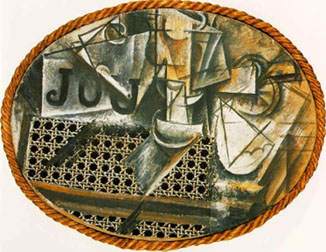
I have to find a focus — “the means of organizing a canvas in terms of interacting and transparent facets or planes, which could be made to suggest movement and depth while preserving the unity of the picture plane.” (John Golding, Cubism). This focus will, of course, be integrated with all the other elements of translucency, interpenetration, angularity, volume, and fragmentation.
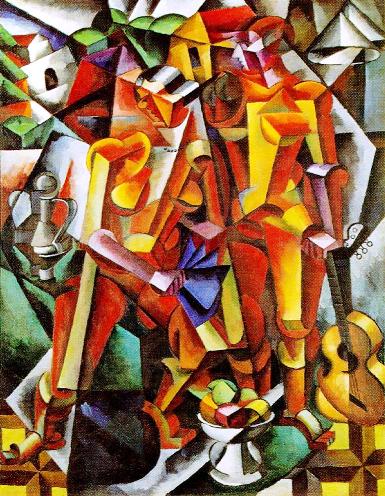
So I am embarked this week on the journey. I have an itinerary and a final station, but the details of the passing landscape are yet to be discovered. I have photographs of vases and jugs. I have made and sketched biscuits to my satisfaction. I have tried out angularities and volumic spaces. I have a big bowl of strawberries. I’m ready to roll.
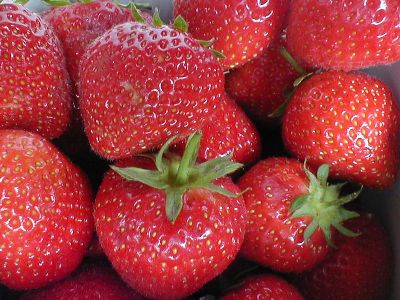
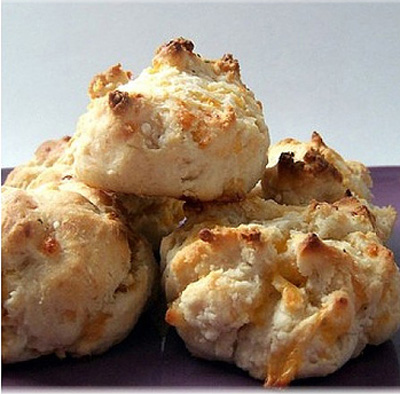

June,
Very cool.
I’ve been thinking about cubism lately. I am wondering, at what moment in the process did the artists first become aware of what they were doing? Was it concept-first, or was it discovery?
At first I thought the Braque was your picture of biscuits, and I thought it was brilliant! This is a fascinating project, and at one point I’ve tried to think how I would apply it in photography. Despite the ease (in some respects) of digital manipulation, I think I’d take a bunch of photos of a subject from different angles that I liked, cut up the prints and make some sort of collage. Or maybe something three-dimensional; cubism seems to care about volume.
June:
Twice in one day!
Making cubist biscuits…with cubist strawberries. Spent more time than it was worth this morning trying to make an anagram for “strawberries” and came up with nothing.
Looking for thoughts? How about the idea that Cubism is something of a four-dimensional affair. Cubism through Braque and Picasso got started soon after Einstein’s “miracle year” of 1905. A biscuit through time might get chomped, so that it’s evolution would be toward carved out shapes and a progressive revelation of interiors.
This is, for me, a mouth watering project as I do love my strawberry shortcake. Makes me want to get some milk or a can of Cool Whip in there somewhere. The Bisquick spoon might be augmented by a Bisquick box or label – depending upon your phase of Cubism.
Karl,
Your question is really one for an expert on the subject. I can only conjecture and circle it.
The process of moving from exaggeration and distortion to Cubism happened very quickly — over the space of a year or two. Picasso’s Demoiselles (not Cubist, but clearly moving toward it) was 1907 and his figures after that became increasingly intertwined,fragmented and focused on volumes. Golding says, “In these pre-Cubist paintings of 1907 and 1908 it is as if Picasso were preparing himself for the difficulties involved in creating a new style….” By 1909, Picasso, Braque, Juan Gris and others were fully into their Cubist work.
The basic element of Cubism — volume without linear or mathmatical perspective — was informed by the African art that Picasso was toying with at the time, as well as by Cezanne — two very unlike influences, but both concerned with volumes and solidity without conventional 19th century European means of expressing them. Golding says that those two years, 1907–08 were spent “analyzing and investigating the nature of solid forms.”
My guess is that Picasso and his fellows, in rebelling against the depleted 19th century modes, kept finding a direction that pushed them to explore further. Braque did some 1908 landscapes, the L’estaque pieces, that Picasso seized on as a means to further his own art. To my amateur eye, the Braque and Picasso landscapes are very cubistic (and Cezannish as well, but that may just be my peculiar interest). Here’s a sample of Braque’s L’estaque work — http://www.artchive.com/artchive/B/braque/housesle.jpg.html
By 1912, a section of the Galerie de la Boetie (Section d’Or) exhibit was reserved for the Cubists. They deliberately organized the works to show successive stages of the movement, apparently in order to bring the public to a greater understanding of it.
So your question is a good one, particularly in that there is so much conceptual analysis surrounding the emergence of Cubism and such an overt awareness on the part of its many practitioners of the stages of development as well as the differences among the practitioners.
I am continually amazed at the difficulty of grasping what is being done, even in an elementary way in a single painting, and this in spite of the fact that I’m looking at what is already in existence. Picasso and his cohorts had to imagine these works into existence — a far more difficult task.
Steve,
What’s that saying “From your mouth to my heart?” Would that the Braque (Still Life with Fruit Dish, 1908-09) were from my fingers!
I think in my internet wanderings I saw a photographer doing “cubist-llike” work. Certainly Hockney comes to mind.
jay,
I’m ahead of you with the Bisquick box, but I think they’ve changed the logo too much. It just doesn’t fit my 1950’s memories. But you are right on about the shortcake! That’s how I got to strawberries as a motif. I wonder how fragmented teeth would come out in a painting (a bit fossilish?) Someone — Gris perhaps — includes lips in his paintings that make me want to smack them — in all the senses of the phrase.
The fourth dimension, though, is much beyond me, although I love the connection to Einstein. Time, in a painting — hmmm — Goldsworthy, in his art, although not the photography. But perhaps inherent in cubism, too — the evolution of the aforenamed shortcake into the human figure…..
June:
you have set for yourself the edibility problem. Will the victuals be to eating as B and P’s guitars were to music?
Speaking of evolutions, there are cases where Picasso portraits morphed into still lives and the obverse.
I’ll try to look the person up, but a book was written recently, proposing a tactile basis for Cubism. The sense of touch verifies vision. Makes me think of your John Days.
Jay,
“Strawberries” gets you “rawer best, sir”. If it’s “and strawberries” you can get “raw darner is best”. Not sure it helps with the cubism, though.
Steve:
I see what you mean. Cubism, schmubism – it still helps.
June:
Let the fourth dimension be with you and guide you.
June. In a timely fashion.
June,
Thanks for this review of the discovery, or creation, of cubism.
I think it is better to do art not “concept first” when one is exploring. The reason is that a concept, formed in words, may distract from or block the real visual breakthrough.
However, when the breakthrough has occurred, when the artist has the feeling that something exciting is going on, then could be the moment for describing in words the visual “concept” that is already formed.
I feel like I am at this point with some of the paintings I am making. That is, I feel something has “happened” or is “happening” with the work, a kind of breakthrough which part of me understand, but not the part of me that can write down the concept. It’s a curious sort of feeling, like having someone excitedly explaining something to you in a language you do not understand. The energy is there, but not the comprehension.
Then again, this feeling of an uninterpreted “breakthrough” might be a visually-inspired “illusion.”
Maybe that is good enough…
Karl,
You cescribe well my usual art-making processes — I try not to verbalize much of anything important about a given work for a long, particularly when I’m just beginning a new series.
The Cubism project, of course, came from words and because I feel no affinity with the art, all I can do was look and read and cling to the hope that something will arise from the process. If something happens, then the process may be more interesting to me than the final product.
Once or twice, as I havelaboriously been making my way through the studies, I will happen upon a line or shape or “fit” that comes from that other place, the place where “something has happened” the place that I think of as making real art. I am not even close to being in control of this yet — I don’t even know exactly what it is — but, as they say, I know it when I see it. The energy is there, even in making something as alien as the cubist work is for me — the energy has emerged for a second or two.
What I am interested in seeing is if I can find the non-articulated ways to bring that energy forth a bit more methodically, or on cue rather than having it appear and disappear at its own whim.
I can easily imagine my excitement at seeing Cubist work, or any work, that challenged a more staid, preconceived vision. Though my introduction to the Modern movement was academic, I prefer now to consider work on a more personal level. The possibilities for experiencing art are wonderful, for the past and certainly, the present.
Did you read the 6 reviews in the Friday NYTimes’ “Art in Review”?
I am always disappointed by how easily we are derailed by Media’s infatuation with Money and passive-aggressive attraction to Dismissal. These reviews suggest, I think, with an open-mind and some willingness, Art thrives (and yes, Karl, in NYC).
June:
I kind of missed your Goldsworthy allusion. And then I didn’t. THAT Goldsworthy… to the extent that he, too, engages in a dynamic balancing act. P&B had their pictorial compositions and he his precariousness. Makes me see the biscuits, forming a bakery rainbow, as they arch from barely baked to burnt. Has happened to me on the beach.
Cubism reduces life to robotic stiffness while real life is humming.